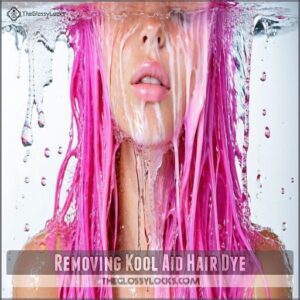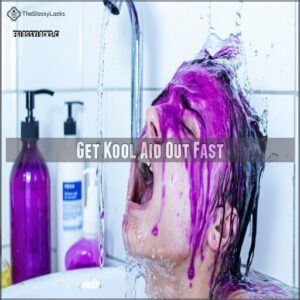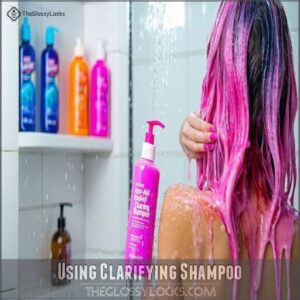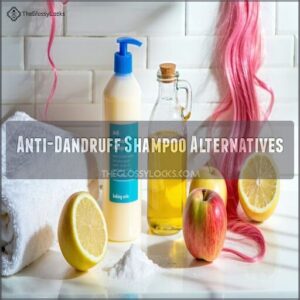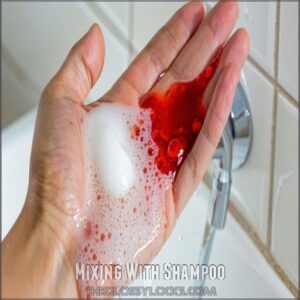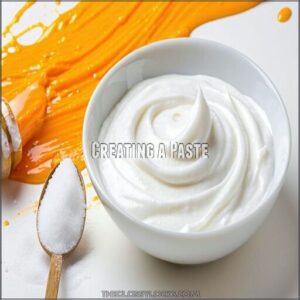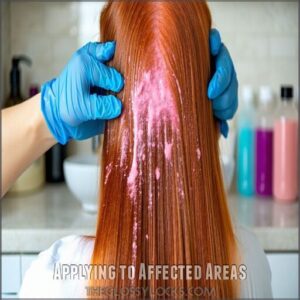This site is supported by our readers. We may earn a commission, at no cost to you, if you purchase through links.
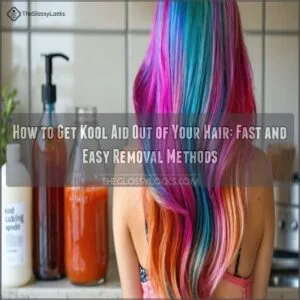 Getting Kool-Aid out of your hair isn’t as tough as it seems.
Getting Kool-Aid out of your hair isn’t as tough as it seems.
Start by using a clarifying shampoo—lather and rinse with warm water to break down the dye.
For stubborn streaks, mix baking soda with shampoo or water to make a paste, then gently scrub. A vinegar rinse also works wonders—equal parts vinegar and water can help lift the color.
Just don’t forget to moisturize afterward, since these methods can dry out your hair. Feeling adventurous? A hot oil treatment or even a dab of dish soap can do the trick too.
Easy fixes that’ll save you some head-scratching!
Table Of Contents
- Key Takeaways
- Removing Kool Aid Hair Dye
- Get Kool Aid Out Fast
- Shampooing Techniques
- Baking Soda Removal Methods
- Alternative Removal Techniques
- Preventing Future Stains
- Frequently Asked Questions (FAQs)
- How do you remove Kool-Aid dye?
- Will Kool-Aid dye my hair?
- How do you get cool tones out of your hair?
- How can you prevent Kool-Aid from staining your hair in the future?
- Can Kool-Aid cause allergic scalp reactions?
- How does hair porosity impact stain intensity?
- Is Kool-Aid hair dye safe for kids?
- Will Kool-Aid damage freshly bleached hair?
- Are specific Kool-Aid flavors easier to remove?
- Conclusion
Key Takeaways
- Use clarifying shampoo or a baking soda paste to break down the Kool-Aid dye and rinse thoroughly with warm water.
- Hydrate your hair afterward with deep conditioner or moisturizing treatments to prevent dryness.
- Try alternative methods like a vinegar rinse, hot oil treatment, or diluted dish soap for stubborn stains.
- Protect your hair before future dyeing by coating it with coconut oil or conditioner to reduce staining.
Removing Kool Aid Hair Dye
Getting Kool-Aid out of your hair might seem tricky, but with the right steps, it’s completely doable.
With patience and the right techniques, you can easily remove Kool-Aid stains and restore your hair’s natural vibrance.
Understanding why the dye sticks and prepping your hair properly will make the process much easier.
Causes of Stubborn Stains
Stubborn Kool-Aid stains happen when hair absorbs color unevenly due to porosity, dye concentration, and extended application time.
Bright colors, especially blue, are notorious for clinging to light hair.
Factors like warm water temperature and hair porosity further complicate removal.
- High dye concentration sticks to porous hair.
- Light or blond hair easily retains bold colors.
- Poor application intensifies discoloration.
- Warm water locks in Kool-Aid stains fast, which can be attributed to porous hair.
Preparation for Removal
Before tackling Kool-Aid hair stain removal, assess your hair condition. Gather supplies like a clarifying shampoo, baking soda, and gloves. Protect surfaces with old towels, then plan your removal method carefully.
Perform a strand test to see how your hair reacts. Understanding hair porosity helps avoid unnecessary hair damage. Baking soda can help, as it lifts the hair dye.
Think ahead—quick actions make hair protection and stain removal much easier!
| Step | Item Needed | Purpose | Tip |
|---|---|---|---|
| Assess Hair | Mirror | Check porosity and condition | Look for dryness or damage |
| Gather Supplies | Baking Soda | Core removal ingredient | Use fresh baking soda |
| Protect Surfaces | Old Towels | Avoid stains | Wrap furniture, counters |
| Perform Strand Test | Mixing Bowl | Test reaction | Use a small hidden section |
Importance of Gentle Hair Care
Removing Kool-Aid hair dye requires patience and a gentle cycle of care.
Patience and gentle care are the keys to effortlessly removing stubborn Kool-Aid hair dye while keeping your hair healthy and vibrant.
Avoid harshness to minimize damage—gentle products like sulfate-free shampoos are your best friend.
Hydration is key for both hair and scalp health, so use deep conditioners to restore moisture.
Treat your strands kindly, and you’ll breeze through hair dye removal without unnecessary stress.
Get Kool Aid Out Fast
When you’re in a panic over bright purple hair from KoolAid hair dye, you’ll want to act quickly.
The longer the dye sits, the deeper it penetrates your strands.
For Immediate Action, assess the Stain Severity first—lighter colors like pink fade faster than deep blues or purples.
Quick Fixes include making a paste with baking soda and water, then applying it to affected areas for 5-10 minutes.
Product Buildup from the dye can be tackled with dish soap (like Dawn), which breaks down the colorants but may dry your hair.
For stubborn stains, a vinegar rinse can help lift the color without causing damage.
If these methods don’t work, consider seeking Professional Help—stylists have specialized products for hair color removal.
Remember, KoolAid contains food dyes that can be surprisingly persistent!
Shampooing Techniques
You’ll need to use specific shampooing techniques to break down those stubborn Kool-Aid molecules clinging to your hair strands.
The right shampoo and washing method can substantially speed up the fading process and get your natural color back faster.
Using Clarifying Shampoo
After multiple failed attempts with regular shampoo, it’s time to bring in the big guns.
Clarifying shampoo works wonders on Kool-Aid hair discoloration because it’s specifically formulated to remove buildup.
You can easily find various types available online.
Depending on your hair type, you’ll want to adjust your shampoo frequency—every other day usually works best for fading hair color without causing potential damage.
Always follow with conditioning aftercare to prevent your locks from drying out, ensuring the best results with clarifying shampoo.
Hot Water Rinsing
Hot water acts as a powerful ally in your battle against stubborn Kool Aid hair staining.
Warm-to-hot water opens hair cuticles, allowing color molecules to escape more easily during rinse duration.
For effective hair rinsing, follow these steps:
- Use water as hot as comfortable without scalp sensitivity issues (105-110°F)
- Rinse continuously for 5-7 minutes to maximize color fading
- Follow with cold water rinse and conditioner pairing to close cuticles and prevent dryness
Applying hydrating formulas, like conditioner, is key to preventing hair damage after rinsing. This helps in maintaining the health of your hair and preventing further hair damage.
Anti-Dandruff Shampoo Alternatives
Several anti-dandruff shampoos contain selenium sulfide, which helps fade Kool-Aid hair dye effectively.
You can boost results by mixing these shampoos with baking soda for a powerful removal paste. Apply the mixture for 30-60 minutes before rinsing with cold water.
For natural alternatives, try lemon juice rinses or vinegar solutions before shampooing. Oil treatments can also help lift color while conditioning your hair, preventing the dryness that harsh removal techniques often cause.
Consider exploring various anti-dandruff shampoo options to find the most suitable product.
Baking Soda Removal Methods
You’ll find that baking soda works wonders as a natural and effective way to remove stubborn Kool-Aid dye from your hair.
When mixed with shampoo or water to form a paste, it’ll gently lift those bright colors without causing the damage that harsher chemical solutions might, making it a natural solution.
Mixing With Shampoo
Mixing baking soda with your regular shampoo creates a powerful KoolAid hair dye remover.
Combine one tablespoon of baking soda with your Shampoo Type at a 1:1 Mixing Ratio. Work this mixture through your hair, focusing on areas with higher Color Intensity.
The Application Process is simple—massage thoroughly, let it sit for 3-5 minutes, then rinse with warm water.
This method impacts Duration of stains, gradually fading your vibrant mishap.
Creating a Paste
While shampoo mixing works well, creating a baking soda paste offers more precision for stubborn KoolAid hair dye.
To achieve the perfect paste consistency, combine two tablespoons of baking soda with one tablespoon of warm water.
Stir until you reach a thick, toothpaste-like texture. The ideal ingredient ratios guarantee your baking soda hair treatment won’t drip while effectively breaking down those vibrant dyes.
Think of it as creating edible slime—for your hair!
Applying to Affected Areas
When applying baking soda paste to areas dyed by Kool-Aid, focus on even coverage for effective color lifting.
Use gloves to prevent skin stain removal struggles, and massage the paste onto hair gently.
Leave it for 15 minutes, then rinse thoroughly.
If removing red dye, purple dye, or other stubborn colors, repeat if needed while conditioning hair afterward to prevent dryness.
Alternative Removal Techniques
If traditional methods haven’t worked, you’ve got a few creative options to tackle Kool-Aid stains.
Simple solutions like vinegar rinses, hot oil treatments, or even dish soap can help lift the color without too much trouble.
Vinegar and Water Solution
A quick fix for Kool-Aid hair removal is a vinegar hair rinse.
The vinegar acidity breaks down the dye, making it easier to wash out.
Mix one tablespoon of vinegar with a cup of water for the perfect solution ratio.
Leave it on your hair for 10 minutes, then rinse thoroughly.
Results vary by hair type, but this hair dye removal method works gently yet effectively.
Hot Oil Treatments
Hot oil treatments are a soothing way to help fade stubborn Kool-Aid hair dye. Warm olive or coconut oil works wonders when combined with gentle heat.
Coat your hair in the warmed oil, wrap it in a towel, and wait. You can find a variety of options online.
- Oil Treatment Benefits: Nourishes and softens hair.
- Oil Type Selection: Go for olive or coconut.
- Heat Application: Use low heat for better absorption.
- Application Techniques: Massage oil evenly, focusing on dyed areas.
- Post-Treatment Care: Follow with a conditioning mask.
Dish Soap Applications
Dish soap, like Dawn, can be a secret weapon for Kool-Aid hair dye removal. Dilute it with water to prevent excess dryness and gently work it through your hair. Use sparingly to avoid damage.
Dawn is effective at removing product buildup.
Here’s a quick guide:
| Step | Details |
|---|---|
| Soap dilution | Mix Dawn with water. |
| Application | Massage onto dyed areas. |
| Frequency | Use 1-2 times weekly. |
| Residue removal | Rinse thoroughly. |
| Moisturizing tip | Follow with conditioner. |
Preventing Future Stains
You can avoid future Kool-Aid hair dye mishaps by taking simple precautions before starting. Protect your clothes and surroundings, and plan ahead to make cleanup easier and stress-free.
Protecting Clothing and Fabrics
Protecting your space and clothes during Kool-Aid dyeing is smart. Avoid those pesky fabric stains by following these tips:
- Cover surfaces with old towels or newspapers.
- Wear an old shirt you don’t mind staining.
- Use gloves to prevent dyed hands.
- Apply petroleum jelly near the hairline to block drips.
- Keep stain removal products handy for quick cleanup.
These precautions will help you have a fun and mess-free Kool-Aid dyeing experience.
Preparing for Future Hair Dye Applications
Before diving into hair dye again, start with strand tests to check porosity levels and how your hair reacts.
Choose softer, chemical-free colors that won’t wreak havoc like Kool-Aid might. Protective measures, like an old towel or gloves, minimize mess.
An aftercare routine, such as conditioning, prevents hair dye damage. Planning ahead helps avoid another stressful hair dye removal session!
To avoid future issues, always consider essential dyeing tools before starting, and remember to take protective measures and have a plan for hair dye damage.
Frequently Asked Questions (FAQs)
How do you remove Kool-Aid dye?
To remove Kool-Aid dye, use clarifying shampoo or a baking soda paste.
Then deep condition to prevent dryness.
Hot water and dish soap work too, but they’ll dry your hair, so moisturize after.
Will Kool-Aid dye my hair?
Yes, Kool-Aid will dye your hair, especially lighter shades like blonde.
It’s a fun, temporary way to add vibrant colors, but be prepared—it can last longer than expected and might slightly dry your hair.
How do you get cool tones out of your hair?
To remove cool tones from your hair, try a clarifying shampoo or a baking soda paste for gradual fading.
Hot oil treatments or vinegar rinses speed things up, but deep condition afterward to prevent dryness.
How can you prevent Kool-Aid from staining your hair in the future?
To prevent Kool-Aid from staining your hair, coat it with a protective layer like coconut oil or conditioner before dyeing.
Stick to washable hair chalk or sprays for temporary color experiments without the hassle.
Can Kool-Aid cause allergic scalp reactions?
Think of Kool-Aid like a wildcard; it’s unlikely, but sensitive scalps might react.
Though Kool-Aid lacks harsh chemicals, its food dyes or preservatives could irritate.
Test a small section first to avoid surprises!
How does hair porosity impact stain intensity?
Hair porosity affects how deeply Kool-Aid soaks into your strands.
Higher porosity means dye grabs on harder, creating more intense color.
Lower porosity resists absorption, so the color might appear lighter or patchy.
Is Kool-Aid hair dye safe for kids?
Imagine turning a family kitchen into a salon—surprisingly, Kool-Aid hair dye is safe for kids.
It’s chemical-free, fun, and temporary,
but remember: protect clothes, keep it off skin, and condition well.
Will Kool-Aid damage freshly bleached hair?
Freshly bleached hair is more porous, so Kool-Aid can cling stubbornly, potentially causing uneven color or dryness.
It’s not permanent damage, but deep conditioning after dyeing helps keep your hair healthy and smooth.
Are specific Kool-Aid flavors easier to remove?
Darker Kool-Aid flavors like purple or red typically stick around longer, making them trickier to remove compared to lighter colors.
Blues can also stain more, so stick to pastel shades if you want easier cleanup.
Conclusion
Don’t worry if getting Kool-Aid out of your hair feels tricky—it’s manageable with the right methods!
Start with a clarifying shampoo, then try baking soda paste or a vinegar rinse for tough spots.
Moisturizing afterward protects your hair from dryness, so don’t skip it, and consider using a hot oil treatment or dish soap for extra care.
Whether you use these steps, they make it easy to tackle those vibrant stains, now you’re ready to enjoy bold looks without the stress!

